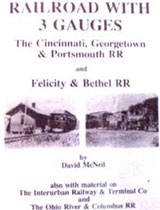Formed in 1958 the Clermont County Historical Society has recorded Clermont County Ohio history for over 50 years.
Early Turnpikes
Things I can Remember, by Cary Miller
Bethel Journal, April 8 1976
1850 to 1860 was the turnpike period, but it seems that the property owners were paying for the cost of the work, for their particular use and also the public. The Felicity and Chilo turnpike was petitioned on April 23, 1867. The Felicity and Utopia, by way of Rural, was petitioned for on December 4, 1866. The assessment by taxes was $22,572.92 for this project. Three views were always appointed for these projects to estimate the cost. In a project, many times different sections of the road would have different costs.
From 1850 and on, when turnpikes were the style, at least ten or twelve toll roads were started by stock companies. It seems that most of them were in the western part of the county. Toll roads seemed to offer the owners a profitable project. The Felicity-Chilo road was at this time of improvement a toll road. But in each case only a few miles were completed and these roads were abandoned, for they did not prove profitable.
A toll road had to have a keeper on each end of the road, where a keeper lived. Then a long pole fastened on one end, so it could be moved up and down. When not in use it was always down. The rates were a bit unusual; the width of the tire on the vehicle regulated the rate. The narrower the tire, the more it cost. A buggy or cart with a one inch tire was the most expensive. A wagon with a two inch tire, not so much. A rate for a horse and rider, and I have always wondered if they charged for a person to walk on the road. The different rates for vehicles were due to the damages to the road. In winter, the buggy with the narrow tires would cut into and damage roads by the freezing weather. Toll roads were always kept in repair. We here in America are using toll roads today; that is alright, for I think when I am riding a toll road in another state, there is no good reason why the folds there should pay for a road for me to use. Toll roads use a different method today to collect toll. When you enter you are given a ticket, and all the exits are marked and price listed. When you get off you will know what the charges are.
Probably the last toll road in Clermont County was a stretch of the road # 125 between Bethel and Amelia, past the old Bantam Fair grounds, or Raps Corner. I cannot remember the old toll houses, but I can remember long piles of rocks left to repair the roads. An old house which has recently burned had something to do with the old toll road. It was an old tavern for many years.
I can remember seeing two men breaking up rocks to resurface the road from Felicity to Bethel that was probably before 1910. I knew one of the men. His name was Rumsey. He could have been the grandfather of the electrician in Felicity today, Virgil Rumsey. I mention piles of rock to be broken into smaller pieces. The men sat on the pile of broken rocks as they worked. They used a cushion to sit on. They used two different kinds of hammers, a sledge and a smaller one, round with a short handle. They sat with their legs on each side of the pile, using a leather glove on the left hand to hold the rocks and hammer in the right hand; this way they moved along as the rocks were broken up. Most of the roads coming into Felicity and other towns usually make a curve where they enter the town, because these roads do not meet the town street straight. While we have been thinking about roads, a very important early road or trace passed through where Felicity is located today…
We never hear about this road or trace; a trace is sort of route or pass. This is the "General Anthony Wayne Trail", which passed through the or over the grounds where Felicity is today….

